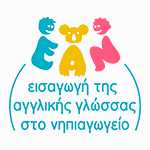| Simon says | The English teacher or a child is “Simon”. The rest of the children gather around “Simon”, who gives orders, saying “Simon says…” and asking children to perform an action. For instance, “Simon says touch your nose”, “Simon says bark like a dog”. Each child needs to perform a particular action, each time. If Simon omits the phrase “Simon says” before giving an order, whichever child performs the action is out of the game. |
| Follow the Leader | The English teacher or a child is the “Leader”, who moves freely making whichever move they desire and combines it with a word/phrase in English (e.g., Jumping while saying “Let’s jump!”). The rest of the children follow, copying the movements and the English phrase/word of the “Leader”. The game can take place either with children seated on the floor or standing in a line. However, it is more fun when the “Leader” can actually move in the available space. |
| The Telephone Game | Children are seated in a circle or in a line. The English teacher or a child thinks of a short phrase/word in English and whispers it to the next in line. The message needs to pass from one child to the next without being altered. The last child in line says the message outloud and the first child in line confirms whether the message is correct or not. |
| I Spy with My Little Eye | The English teacher chooses an object seen in the surrounding space and describes it for the children to guess what it is. For instance, “Ι spy with my little eye something red”. Later on, the “spy” can be a child in the classroom. |
| Categories Game | The English teacher chooses a category (e.g., Shopping list) and asks each child, at their turn, to add an English word (e.g. tomato, apples, etc.) on the list that fits the category. The children should not repeat words that have already been added to the list. |
| Musical Chairs | The English teacher places chairs in a circle. The number of chairs is one less than the number of children playing, and plays some music as children walk around the perimeter of the chair circle. Each time the music stops, the English teacher says “Find your seat!”*, and children need to sit on a chair. The children that do not have a seat, are out of the game. Later on, the English teacher removes one more chair and the game continues. *The phrase can be different or can be a word in English, depending on what the children have agreed on with the teacher. |
| Freeze Dance | The English teacher plays a favourite English song. The children must “freeze” when the music stops and the English teacher says “Everyone freeze!”. During this game, a variety of music styles and rhythms can be using, encouraging different types of dance and movement. The teachers can use their smartphone and a bluetooth speaker in order to pause the music without the children noticing it. |
| Please Mr. Crocodile | A child is chosen to be “Mr. Crocodile”. All the other children stand side by side on one side of the school yard or the classroom, looking in the opposite direction. Mr. Crocodile stands in the middle of the school yard or the classroom. Players shout: “Please Mr. Crocodile may we cross the river? If not, why not, what’s your favourite colour?”. Mr Crocodile shouts the name of a colour (e.g., blue) and any child that wears this colour can cross to the other side of the yard/classroom. As soon as children have crossed to the other side, the children who do not wear the aforementioned colour try to run to the other side of the school yard/classroom without getting caught by Mr. Crocodile. The child that is caught becomes the next Mr. Crocodile and the game goes on. |
| Story Time Clap | The English teacher chooses to narrate a story or a book. Then, each time the English teacher says a particular word or phrase, while narrating the story, the children need to clap each time they hear it. |
